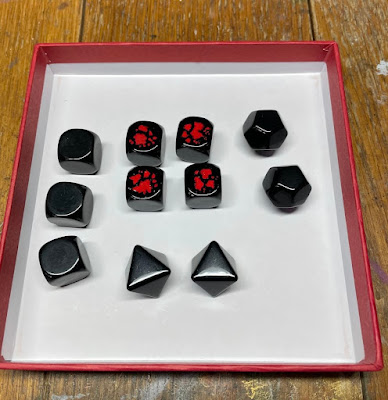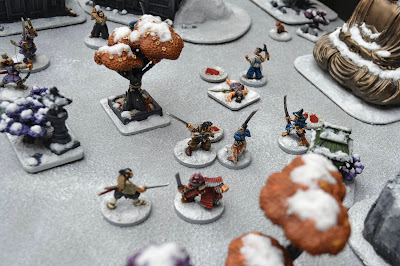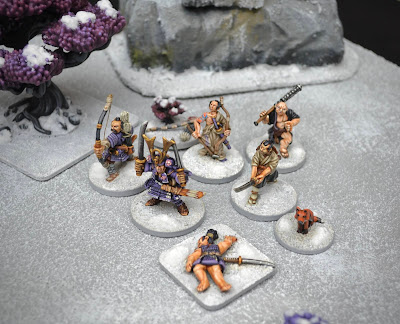********
"Something terrible has happened at the small mountain monastery of Ikoto. The monastery is under the protection of the House of Akiyama, and is located halfway up the steep slopes of Mount Norikata.
A few hours ago, a badly wounded messenger from Ikoto has informed Lord Akiyama that the monastery has been attacked and that several monks have been slain.
Worst of all, the sacred relics of Ikoto appear to be at risk of being stolen or destroyed.
The perpetrators of this dishonourable act are the fallen house of Ichimonji, a ruined noble family long jealous of the Akiyama.
Can the Akiyama avenge the murdered monks and protect the sacred relics of Ikoto? Or will the Ichimonji further despoil the monastery and violate the religious treasures of Mount Noritaka?"
********
This was the introduction to one of my games of “When the Last Sword is Drawn”, which I have being running at games days up and down the UK for the last couple of years. This year, I decided to change the setting of the action from a summer to a winter setting - and so far, in 2024, I’ve run a dozen participation games at games days, and a couple of play-test games with groups of friends. This is the fourth game setting of “When the Last Sword is Drawn” - the other three being in summer (or, at at least, not winter) settings.
All the games have been a blast to run, with players cheerfully slaughtering each other in the monastery of Ikoto. Many characters have fallen under the impassive stare of the huge bronze Diabutsu of the monastery, with some of them suffering truly dramatic (and cinematic) ends. And a couple of unfortunate characters have even tumbled to a terrible fate from the steep slopes of the bell tower at the top of the mountain.
I thought that the time might be right for a look on the Blog behind the scenes in running our games of “When the Last Sword is Drawn”. Much of what follows applies to our games of “With Flashing Blades” that I’ve been running occasionally at the same time.
Terrain
As “When the Last Sword is Drawn” is played on a small board or table, the name of the game is trying to maximise the action without the terrain getting in the way.
This means trying to make the terrain representational without needing to be a totally accurate recreation of a mountain monastery. I used some skills from the 1990s in making terrain for Warhammer to create the functional, but hopefully attractive, mountain-sides of Mount Norikata. The intervals in the blue styrofoam mountain were helpful for gauging the distances to be climbed, and the ledges created by the styrofoam were perfect for inspiring cinematic duels on rocky ledges.
And just as important, these types of terrain pieces can be transported very easily.
Focal scenery
I like my games to have a visual anchor point. It’s a bit of a trick, but having something on the board which looks authentically Japanese helps. If you can catch the eye of the players and passers-by with something which looks right, you can use that to draw the viewer into the smaller details.
This also helps in setting the scene quickly - in a wargame you don’t always have as long as you would like to do that.
In this regard, 3D printing has been wonderful in enabling me to find things in the real world and converting those to the tabletop (with the help of some wonderful friends and their 3D printers!). Here’s a spectacular Buddha from the National Museum of Scotland, transitioned (complete with mandorla) to the table top.
What’s the Game About?
This is the hardest part of running a game you’ve designed yourself. “What’s going on?” “I’ve played other Japanese games before - how is this different?” “Is this like Test of Honour/Bushido/Ronin….?”
All valid questions, and one of the hardest things about any game is working out what it’s about. Or, as one gamer said to me, “I quite like [insert popular set of rules], I think that gives me everything that I’m looking for”.
Comments like that might seem a little bit existential, but I liked it. It made me think not so much about how the game worked, but why it needed to work a particular way compared to other games which have already been produced.
The (excellent) roleplaying game “
Monsterhearts” sets out what its about in a very up front and direct way, that the MC can read to the players. So I’ve tried experimenting with something similar to read at the start of "
When the Last Sword is Drawn" - ideally as soon as the players have sat at the table:
"Welcome to When the Last Sword is Drawn. This game is about three things. The pursuit of Honour. The skill of Swordplay. And the theme of blood.
All three are common elements in Japanese art, films, history and legends focused on medieval and early modern Japan. My promise to all of you is that you'll see each of these in the game across this table in the next couple of hours.
One may ask, of you all, why are you gathered here at this location?
You are here to enhance your honour, because for the samurai, honour is the essence of your life. Honour is what provides your position in society, what gains the respect of your family, your house and your enemies. Honour is the heart of your world.
And we are assembled here to show our swordsmanship. Because the sword is at the spiritual heart of the samurai. The sword is a way of expressing your valour, a visceral and kinetic messenger of your fame.
And we are gathered here to witness the flow of blood. Because the path of the samurai is inextricably marked with blood and the risk of death."
Table Candy
Taking the best bits from other games I love is part of the fun in designing a game. Standing on the shoulders of giants, in other words. I've always admired the cards which are included in Fantasy Flight boardgames and in games produced by Games Workshop. Of course, those giants of the hobby have teams of incredibly talented graphic artists. And I have, well....good intentions and Microsoft PowerPoint...
I’ve created individual cards for each of the characters in the games we’ve played. This allows weapons, skills, status, wounds and some general flavour-text to be shown for each character (and there are usually 5 to 8 characters a side in the game). Each card also has an image of the character, which helps players keep track of which character is doing what and where they are on the table.
Trying to make the cards, and other board-adjacent items, attractive was something I wanted to try to achieve. I wanted to make what goes around the board as much part of the game as what is happening on the main stage, so to speak.
Scatter
The "scatter" scenery was important on the board. Temple lanterns. A frozen pond with fish still visible under the ice. A small shrine. These items of scenery look good, and they connect visually with the Japanese theme.
But they also form small barriers to break up or channel the flow of the fighting. I’ve found over the games of “When the Last Sword is Drawn”, and “With Flashing Blades”, that the games play best when there is not just one fight in the middle of the table. Scatter helps enormously in orientating the different routes the action might take.
Making combat fast, deadly but also interesting
“When the Last Sword is Drawn” , and “With Flashing Blades” are games about combat. They focus on swordplay (and other hand-to-hand fighting methods). They are not long games, and the combat is quick and is intended to be brutal.
But I also wanted to find ways to make the combat interesting. One refinement over the course of this year has been the addition of “Duelling Cards”. One of these Duelling Cards is chosen by each character at the start of their duel to set a theme for that combat.
An iaijustsu sword stroke. Or a dirty trick. Or moving for an advantage. Or, maybe, declaring your name and gaining honour. Players seem to have enjoyed the little bit of drama these cards inject into the duels on the tabletop.
Keeping things cinematic
One thing I always wanted was to ensure that the games being played were fun. Sometimes that means springing some surprises. That'll be the subject of the next blog post - which is all about designing scenarios.
Hope you can join me for that.
********



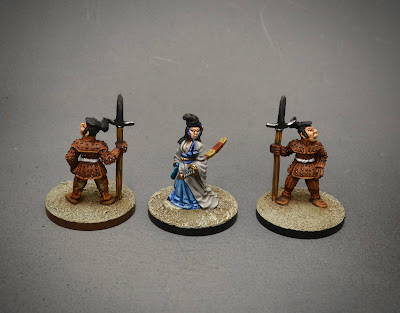







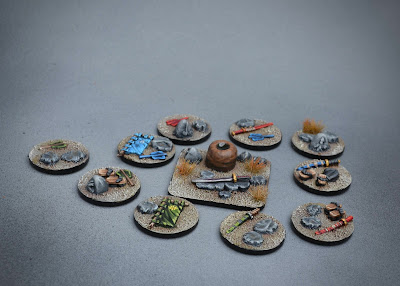
.jpg)







